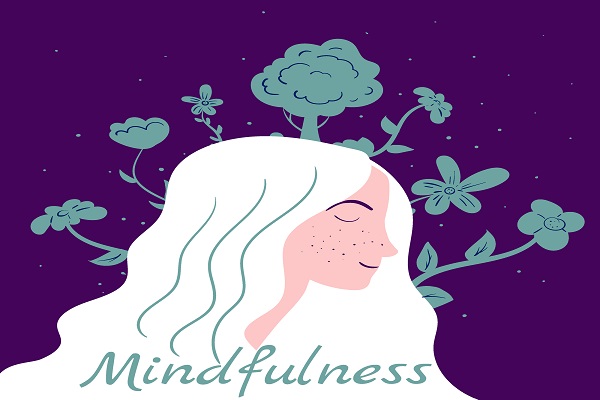
Powerful. Flexible. Intuitive. Innovative. Transformative.
Mindfulness is a word you hear a lot today. It usually conjures up images of someone sitting in meditation, being…mindful.
But what is mindfulness, exactly and why is everyone talking about it?
Mindfulness isn’t new. In fact, the concept comes from millennia-old practices of Tibetan, Buddhist, Zen and Vipassana meditation.
In the 1960s and 70s, the concept of mindfulness migrated to the West along with many other ideas related to Eastern philosophy and religion.
In its barest essence, mindfulness is about being consciously aware in the present moment.
It includes being aware of thoughts, feelings, sensations, movements and all that encompasses your experiences in the here and now without allowing memories from the past or projections about the future color your current experiences.
The practice of mindfulness has been popularized in our time by teachers and practitioners such as Thich Nhat Hahn, Jon Kabat-Zinn, Deepak Chopra and Eckhart Tolle.
How Do We Practice Mindfulness?

There are many ways to practice mindfulness.
Mindful body scan– A body scan is a way for you to focus your attention and slow your thoughts.
To practice body scanning, lie on your back with your arms by your sides, palms up. Relax completely.
When you are ready, begin bringing your attention to each part of your body in order from the top of your head to the soles of your feet and back up again. Try not to skip over any parts.
Remain conscious and aware as you bring your attention to each part of your body and notice any sensations, feelings or thoughts that arise in those areas.
The first time you do a body scan, it can be difficult to keep your attention. You may want to set a timer so you don’t perform the scan too quickly and “mindlessly”.
Try setting a timer for 5 minutes for your first scan. Then increase it gradually to 10 minutes, 20 minutes and up to an hour.
Mindful meditation on your breathing– Our breath is an incredible tool for mindfulness. It’s an involuntary process and one that we can feel most acutely in our bodies.
For example, our heartbeat is also involuntary, but it’s quite subtle and difficult to really sense. Breathing, however, comes with a range of sensations that we can use to help us stay mindful and in the present moment.
To practice mindful meditation on your breathing, sit in a comfortable cross-legged seated position, or sit on a chair and close your eyes. Without altering your natural breathing pattern, simply bring your attention to your breath and all the sensations associated with it.
Start with your inhalation. Feel the sensations of air passing over your nostrils. Notice the temperature of the air in your nostrils and down your throat as you inhale. As you exhale, sense the warmth of the air returning from your lungs and out your nostrils.
Notice any sensations around your nostrils as you exhale. Continue noticing the temperature and sensations of your inhalation and exhalation.
Eventually, bring your attention also to the expansion of the ribcage and the belly as the lungs inflate on the inhalation and the gentle contraction of the ribcage and belly as you exhale.
Remember to allow the breath to be smooth and natural. Don’t take deep inhalations and exhalations in order to feel the sensations more strongly. Just notice the sensations associated with your natural breathing.
Set a timer and practice for 5 minutes to start, then gradually increasing to up to an hour of mindful meditation on your breathing.
Mindful walking meditation– Walking meditation is an excellent method for practicing mindfulness.
Find a space where you can walk freely, ideally for at least 10 steps in one direction. If you have more space, choose the distance you want to walk before turning.
Go only as far as that distance and turn. You can walk that distance back and forth as many times as you like while you practice your mindfulness walking meditation.
Taking slow, conscious steps, begin by paying attention to your feet as you walk.
Notice if there is a gentle heel-toe roll or if your walk has other characteristics. Notice how your balance is challenged as you slow down and sense the shift of your weight as you transfer from one leg to the other.
Try maintaining a soft gaze on the horizon as you walk, taking in the objects and light in your field of vision but without concentrating your gaze on any one thing.
Expand your awareness to include all of these objects and sensations, but without identifying closely with any of them, simple noticing them.
You may count your steps as you walk to help you stay focused.
You can also incorporate other sensations into your mindful walking meditation, such as focusing on sounds or smells.
Mindful eating– Eating is another tool for practicing mindfulness. Sit down at a table with your plate or bowl of food. For a few moments, simply look at your food.
Notice the colors and forms of it. Next, inhale deeply, sensing the food’s aromas. Finally, using a utensil or your hands, take your first bite. Chew very slowly, at least twenty times.
Notice the taste- is the food salty, sweet or sour? If you can, sense the areas of your tongue that are activated by the food’s characteristics.
Notice it’s temperature and texture. After you swallow, sit for a few moments and sense the taste that has remained in your mouth, even though the food is no longer there.
Then, take the next bite and repeat. The practice is more dynamic if you have a variety of foods so you can notice different temperatures, textures and tastes.
Why Should We Practice Mindfulness?

Now that you have some mindfulness exercises that you can practice, you might be wondering what are the benefits of mindfulness? Why should we do these practices?
Practicing mindfulness has been proven in clinical studies to have many positive effects, including:
Alleviates depression – Mindfulness decreases the tendency to ruminate, alleviating this major symptom of depression.
Reduces anxiety and stress- Mindfulness has a calming effect on the sympathetic nervous system, responsible for the fight or flight response, that helps reduce anxiety and stress.
Reduces emotional reactivity– Helps us to stay calm and respond more rationally to situations rather than having knee-jerk reactions based on immediate impressions and emotions.
Improves focus– The practice of mindfulness sharpens the mind’s ability to focus on a single task for longer periods of time, processing information without getting tired or allowing the mind to wander.
Improves self-observation – Mindfulness practice enhances our cognition and gives us greater insight into ourselves, helping us to become more self-aware.
Another powerful practice to enhance our ability to practice mindfulness, is using daily mindfulness affirmations.
You can repeat these affirmations aloud each day, write them down on a piece of paper and tape them to a place where you will see them every day or develop your own mindfulness affirmation practice that works for you.
Daily Mindfulness Affirmations:
- I am calm, present and serene.
- I exist here and now.
- There is nothing to worry about.
- The present is happening in this moment.
- I cannot change the past or predict the future, all I can do is breathe and be in the present moment.
- I am aware of each inhalation and each exhalation.
- There is no need to rush or worry; I am safe and whole in this moment.
- I choose to focus on the here and now where I am free from stress and worry.
- My mind is calm, relaxed and focused.
- Life is a precious gift that unfolds one moment at a time.
- I allow my feelings to rise and pass away like waves rising and falling on the ocean.
- I am released from fear and free to live autonomously.
- I am deeply supported by the universe and have no need to direct or control anything.
- I am fully aware of all thoughts, feelings and sensations in this moment.
- I offer the gift of my consciousness to each and every part of my body.
- My walking is a meditation that takes me closer to my true Home.
- I am whole and complete only in the present moment.
- I offer love and acceptance to feelings and sensations that I find challenging.
- I promise to be present in each moment today, and if I lose my focus, I will gently bring my mind back to the now.
- There is joy in living one moment at a time.
- I savor each bite of food with new awareness and appreciation.
- As I slow down to appreciate each moment of my day, I naturally enter into harmony with others and my surroundings.
- I deserve inner peace and calm.
- As I allow each moment to unfold before me, I enter into life’s stream with ease.
Conclusion
The long-standing practice of mindfulness is an effective tool to take us out of reactivity mode and off of autopilot.
Mindfulness practice allows us deeper insight into our thoughts and feelings and helps us to cultivate self-awareness.
With consistent mindfulness practice, we can reduce things like depression, stress and anxiety and increase focus, cognition and control over emotional reactivity.
Use the mindfulness practices and daily mindfulness affirmations to experience a positive shift in your self-knowledge and well-being and share your experiences below.
You may also be interested in:
1. Positive Affirmations For Love
2. Affirmations For Self-Confidence
3. Positive Affirmations For Men
4. Positive Affirmations For Women
![Profound Meditation Program [Full Spectrum]](https://meditationbrainwaves.com/wp-content/uploads/2021/08/pmp-3-image-23.08.2021.jpg)


